Assessment of Selected Chemical and Morphological Properties of Lonicera var. kamtschatica and Lonicera var. emphyllocalyx Treated with Gaseous Ozone
Abstract
1. Introduction
2. Results and Discussion
2.1. Changes in pH and Acidity in L. kamtschatica and L. emphyllocalyx Fruits in Relation to Ozonation Time
2.2. Contents of Bioactive Compounds in L. kamtschatica and L. emphyllocalyx Berries
| Variable | Ascorbic Acid [mg·100 g−1] | Total Polyphenols Content [mg·100 g−1] | FRAP [µM Fe2+·g−1] | DPPH [% Inhibition] | ABTS [µM TE·g−1] | |
|---|---|---|---|---|---|---|
| Variety | L. caerulea var. kamtschatica | |||||
| Vostorg | 51.05 ab | 310.12 d | 28.97 c | 82.16 ab | 0.33 c | |
| Jugana | 49.74 a | 261.38 ab | 29.81 b | 79.89 a | 0.31 a | |
| Aurora | 54.32 d | 278.08 c | 25.42 a | 79.50 a | 0.36 d | |
| L. caerulea var. emphyllocalyx | ||||||
| 21-17 | 57.80 bc | 276.05 bc | 29.53 bc | 83.10 ab | 0.35 c | |
| 139-24 | 53.13 cd | 231.59 a | 28.00 b | 82.87 ab | 0.34 b | |
| Lori | 54.08 d | 286.92 b | 29.48 c | 85.41 b | 0.36 c | |
| SL | *** | *** | *** | *** | *** | |
| Ozone exposure time [min] | Control | 51.74 a | 251.57 a | 27.78 a | 82.37 cd | 0.33 a |
| 1 min | 53.98 a | 266.78 b | 28.22 ab | 81.62 ab | 0.35 b | |
| 3 min | 51.69 a | 299.71 c | 28.51 ab | 85.14 d | 0.34 ab | |
| 5 min | 52.81 a | 278.27 b | 29.64 b | 79.15 a | 0.35 b | |
| SL | ns | *** | *** | *** | *** | |
| Year of harvest | 2022 | 53.92 b | 390.88 b | 32.69 b | 83.44 b | 0.33 a |
| 2023 | 50.43 a | 212.31 a | 22.14 a | 85.50 b | 0.35 b | |
| 2024 | 53.18 b | 219.05 a | 30.78 b | 79.48 a | 0.35 b | |
| SL | *** | *** | *** | *** | *** | |
2.3. Determination of the Morphology and Colour of Berries
3. Materials and Methods
3.1. Material
3.2. Ozone Treatment of Berries
3.3. Determination of pH and Acidity
3.4. Determination of the Contents of Bioactive Compounds in Fruit and Determination of Their Antioxidant Activity
3.5. Determination of the Morphological Characteristics of Berries
3.6. Colour of L. kamtschatica and L. emphyllocalyx Berries
3.7. Statistical Analysis
4. Conclusions
Author Contributions
Funding
Institutional Review Board Statement
Informed Consent Statement
Data Availability Statement
Conflicts of Interest
References
- Senica, M.; Stampar, F.; Mikulic-Petkovsek, M. Blue honeysuckle (Lonicera cearulea L. subs. edulis) berry; a rich source of some nutrients and their differences among four different cultivars. Sci. Hortic. 2018, 238, 215–221. [Google Scholar] [CrossRef]
- Bieniek, A.A.; Grygorieva, O.; Bielska, N. Biological Properties of Honeysuckle (Lonicera caerulea L.): A Review: The nutrition, health properties of honeysuckle. Agrobiodiversity Improv. Nutr. Health Life Qual. 2021, 5, 11–30. [Google Scholar] [CrossRef]
- Kucharska, A.Z.; Sokół-Łętowska, A.; Oszmiański, J.; Piórecki, N.; Fecka, I. Iridoids, Phenolic Compounds and Antioxidant Activity of Edible Honeysuckle Berries (Lonicera caerulea var. kamtschatica Sevast.). Molecules 2017, 22, 405. [Google Scholar] [CrossRef] [PubMed]
- Yamamoto, Y.; Hoshino, Y.; Masago, H.; Kawano, T. Attempt for postharvest ripening of immature fruits of Haskap (Lonicera caerulea L. var. emphyllocalyx Nakai), an emerging fruit in Northern Japan. Adv. Hortic. Sci 2014, 28, 244–249. [Google Scholar]
- Rupasinghe, H.P.V.; Arumuggam, N.; Amararathna, M.; De Silva, A.B.K.H. The potential health benefits of haskap (Lonicera caerulea L.): Role of cyanidin-3-O-glucoside. J. Funct. Foods 2018, 44, 24–39. [Google Scholar] [CrossRef]
- Caprioli, G.; Iannarelli, R.; Innocenti, M.; Bellumori, M.; Fiorini, D.; Sagratini, G.; Vittori, S.; Buccioni, M.; Santinelli, C.; Bramucci, M.; et al. Blue honeysuckle fruit (Lonicera caerulea L.) from eastern Russia: Phenolic mcomposition, nutritional value and biological activities of its polar extracts. Food Funct. 2016, 7, 1892–1903. [Google Scholar] [CrossRef]
- Rupasinghe, H.P.V.; Yu, L.J.; Bhullar, K.S.; Bors, B. Haskap (Lonicera caerulea): A new berry crop with high antioxidant capacity. Can. J. Plant Sci. 2012, 92, 1311–1317. [Google Scholar] [CrossRef]
- Gorzelany, J.; Basara, O.; Kapusta, I.; Paweł, K.; Belcar, J. Evaluation of the Chemical Composition of Selected Varieties of L. caerulea var. kamtschatica and L. caerulea var. emphyllocalyx. Molecules 2023, 28, 2525. [Google Scholar]
- Senica, M.; Stampar, F.; Mikulic-Petkovsek, M. Different extraction processes affect the metabolites in blue honeysuckle (Lonicera caerulea L. subsp. edulis) food products. Turk. J. Agric. For. 2019, 43, 576–585. [Google Scholar]
- Miller, F.A.; Silva, C.L.; Brandao, T.R. A review on ozone-based treatments for fruit and vegetables preservation. Food Eng. Rev. 2013, 5, 77–106. [Google Scholar] [CrossRef]
- Piechowiak, T.; Grzelak-Błaszczyk, K.; Sójka, M.; Balawejder, M. One-time ozone treatment improves the postharvest quality and antioxidant activity of Actinidia arguta fruit. Phytochemistry 2022, 203, 113393. [Google Scholar] [CrossRef] [PubMed]
- Fan, X. Gaseous ozone to preserve quality and enhance microbial safety of fresh produce: Recent developments and research needs. Compr. Rev. Food Sci. Food Saf. 2021, 20, 4993–5014. [Google Scholar] [CrossRef] [PubMed]
- Zapałowska, A.; Matłok, N.; Zardzewiały, M.; Piechowiak, T.; Balawejder, M. Effect of Ozone Treatment on the Quality of Sea Buckthorn (Hippophae rhamnoides L.). Plants 2021, 10, 847. [Google Scholar] [CrossRef] [PubMed]
- Piechowiak, T.; Antos, P.; Kosowski, P.; Skrobacz, K.; Józefczyk, R.; Balawejder, M. Impact of ozonation process on the microbiological and antioxidant status of raspberry (Rubus ideaeus L.) fruit during storage at room temperature. Agric. Food Sci. 2019, 28, 35–44. [Google Scholar] [CrossRef]
- Kaur, K.; Pandiselvam, R.; Kothakota, A.; Ishwarya, S.P.; Zalpouri, R.; Mahanti, N.K. Impact of ozone treatment on food polyphenols—A comprehensive review. Food Control 2022, 142, 109207. [Google Scholar] [CrossRef]
- Rupasinghe, H.P.V.; Boehm, M.A.; Sekhon-Loodu, S.; Parmar, I.; Bors, B.; Jamieson, A.R. Anti-inflammatory activity of haskap cultivars is polyphenols-dependent. Biomolecules 2015, 5, 1079–1098. [Google Scholar] [CrossRef]
- Molina, A.K.; Vega, E.N.; Pereira, C.; Dias, M.I.; Heleno, S.A.; Rodrigues, P.; Fernandes, I.P.; Barreiro, M.F.; Kostić, M.; Soković, M.; et al. Promising Antioxidant and Antimicrobial Food Colourants from Lonicera caerulea L. var. Kamtschatica. Antioxidants 2019, 8, 394. [Google Scholar] [CrossRef]
- Gerbrandt, E.M.; Bors, R.H.; Meyer, D.; Wilen, R.; Chibbar, R.N. Fruit quality of Japanese, Kuril and Russian blue honeysuckle (Lonicera caerulea L.) germplasm compared to blueberry, raspberry and strawberry. Euphytica 2020, 216, 1–17. [Google Scholar] [CrossRef]
- MacKenzie, J.O.; Elford, E.M.; Subramanian, J.; Brandt, R.W.; Stone, K.E.; Sullivan, J.A. Performance of five haskap (Lonicera caerulea L.) cultivars and the effect of hexanal on postharvest quality. Can. J. Plant Sci. 2018, 98, 432–443. [Google Scholar] [CrossRef]
- Cheng, K.; Bangzhu, P.; Fang, Y. Volatile composition of eight blueberry cultivars and their relationship with sensory attributes. Flavour Fragr. J. 2020, 35, 443–453. [Google Scholar] [CrossRef]
- de Ancos, B.; Gonzalez, E.; Cano, M. Differentiation of raspberry varieties according to anthocyanin composition. Z. Für. Leb. Und-Forsch. A 1999, 208, 33–38. [Google Scholar] [CrossRef]
- Temocico, G.; Sturzeanu, M.; Ion, V.; Cristea, S. Evaluation of strawberry fruit quality for new selections and cultivars. Rom. Biotechnol. Lett. 2019, 24, 742–748. [Google Scholar] [CrossRef]
- Akhtar, I.; Rab, A. Effect of the fruit ripening stages on strawberry (Fragaria x ananasa Duch) fruit quality for fresh consumption. J. Agric. Res. 2015, 53, 413–424. [Google Scholar]
- Horvitz, S. Postharvest handling of berries. Postharvest Handl. 2017, 6, 107–123. [Google Scholar]
- Gorzelany, J.; Belcar, J.; Kuźniar, P.; Niedbała, G.; Pentoś, K. Modelling of Mechanical Properties of Fresh and Stored Fruit of Large Cranberry Using Multiple Linear Regression and Machine Learning. Agriculture 2022, 12, 200. [Google Scholar] [CrossRef]
- Kuźniar, P.; Belcar, J.; Zardzewiały, M.; Basara, O.; Gorzelany, J. Effect of Ozonation on the Mechanical, Chemical, and Microbiological Properties of Organically Grown Red Currant (Ribes rubrum L.) Fruit. Molecules 2022, 27, 8231. [Google Scholar] [CrossRef]
- Du, J.; Cullen, J.J.; Buettner, G.R. Ascorbic acid: Chemistry, biology and the treatment of cancer. Biochim. Biophys. Acta 2012, 1826, 443–457. [Google Scholar] [CrossRef]
- Njus, D.; Kelley, P.M.; Tu, Y.J.; Schlegel, H.B. Ascorbic acid: The chemistry underlying its antioxidant properties. Free Radic. Biol. Med. 2020, 159, 37–43. [Google Scholar] [CrossRef]
- Ochmian, I.; Grajkowski, J.; Skupień, K. Field performance, fruit chemical composition and firmness under cold storage and simulated “shelf-life” conditions of three blue honeysuckle cultigens (Lonicera caerulea). J. Fruit Ornam. Plant Res. 2008, 16, 83–91. [Google Scholar]
- Česonienė, L.; Labokas, J.; Jasutienė, I.; Šarkinas, A.; Kaškonienė, V.; Kaškonas, P.; Kazernavičiūtė, R.; Pažereckaitė, A.; Daubaras, R. Bioactive compounds, antioxidant, and antibacterial properties of Lonicera caerulea berries: Evaluation of 11 cultivars. Plants 2021, 10, 624. [Google Scholar] [CrossRef]
- Jabłońska-Ryś, E.; Zalewska-Korona, M.; Kalbarczyk, J. Antioxidant capacity, ascorbic acid and phenolics content in wild edible fruits. J. Fruit Ornam. Plant Res. 2009, 2, 115–120. [Google Scholar]
- Turmanidze, T.; Gulua, L.; Jgenti, M.; Wicker, L. Potential antioxidant retention and quality maintenance in raspberries and strawberries treated with calcium chloride and stored under refrigeration. Braz. J. Food Technol. 2017, 20, 2016089. [Google Scholar] [CrossRef]
- Turmanidze, T.; Jgenti, M.; Gulua, L.; Shaiashvili, V. Effect of ascorbic acid treatment on some quality parameters of frozen strawberry and raspberry fruits. Ann. Agrar. Sci. 2017, 15, 370–374. [Google Scholar] [CrossRef]
- Svarcovaa, I.; Heinrichb, J.; Valentovaa, K. Berry fruits as a source of biologically active compounds: The case of Lonicera caerulea. Biomed. Pap. Med. Fac. Palacky Univ. Olomouc 2007, 151, 163–174. [Google Scholar] [CrossRef] [PubMed]
- Zdarilová, A.; Svobodvaá, A.R.; Chytilová, K.; Simánek, V.; Ulrichová, J. Polyphenolic fraction of Lonicera caerulea L. fruitsreduces oxidative stress and inflammatory markers induced by lipopolysaccharide in gingival fibroblasts. Food Chem. Toxicol. 2010, 48, 1555–1561. [Google Scholar] [CrossRef]
- Pažereckaitė, A.; Jasutienė, I.; Šarkinas, A.; Česonienė, L. Antimicrobial Activity and Composition of Different Cultivars of Honeysuckle Berry Lonicera caerulea L. Biol. Life Sci. Forum. 2021, 4, 71. [Google Scholar]
- Khattab, R.; Brooks, M.S.-L.; Ghanem, A. Phenolic analyses of haskap berries (Lonicera caerulea L.): Spectrophotometry versus high performance liquid chromatography. Int. J. Food Prop. 2016, 19, 1708–1725. [Google Scholar] [CrossRef]
- Ochmian, I.D.; Skupien, K.; Grajkowski, J.; Smolik, M.; Ostrowska, K. Chemical composition and physical characteristics of fruits of two cultivars of blue honeysuckle (Lonicera caerulea L.) in relation to their degree of maturity and harvest date. Not. Bot. Horti Agrobot. Cluj-Napoca 2012, 40, 155–162. [Google Scholar] [CrossRef]
- Lee, Y.S.; Cho, I.J.; Kim, J.W.; Lee, S.K.; Ku, S.K.; Lee, H.J. Evaluation of in vitro anti-oxidant and anti-inflammatory activities of Korean and Chinese Lonicera caerulea. Nutr. Res. Pract. 2018, 12, 486–493. [Google Scholar]
- Oszmiański, J.; Wojdyło, A.; Lachowicz, S. Effect of dried powder preparation process on polyphenolic content and antioxidant activity of blue honeysuckle berries (Lonicera caerulea L. var. kamtschatica). LWT-Food Sci. Technol. 2016, 67, 214–222. [Google Scholar]
- Auzanneau, N.; Weber, P.; Kosińska-Cagnazzo, A.; Andlauer, W. Bioactive compounds and antioxidant capacity of Lonicera caerulea berries: Comparison of seven cultivars over three harvesting years. J. Food Compos. Anal. 2018, 66, 81–89. [Google Scholar] [CrossRef]
- PN-EN 12147:2000; Fruit and Vegetable Juices—Determination of Titrable Acidity. Polish Committee for Standardization: Warsaw, Poland, 2000.
- PN-A-04019:1998; Food Products—Determination of Vitamin C Content. Polish Committee for Standardization: Warsaw, Poland, 1998.
- Bakowska-Barczak, A.M.; Marianchuk, M.; Kolodziejczak, P. Survey of bioactive components in Western Canadian berries. Can. J. Physiol. Pharmacol. 2007, 85, 1139–1152. [Google Scholar] [CrossRef] [PubMed]
- Jurčaga, L.; Bobko, M.; Kolesárová, A.; Bobková, A.; Demianová, A.; Haš’cík, P.; Belej, L.; Mendelová, A.; Bučko, O.; Kročko, M.; et al. Blackcurrant (Ribes nigrum L.) and Kamchatka Honeysuckle (Lonicera caerulea var. Kamtschatica) Extract Effectson Technological Properties, Sensory Quality, and Lipid Oxidation of Raw-Cooked Meat Product (Frankfurters). Foods 2021, 10, 2957. [Google Scholar] [CrossRef] [PubMed]
- Gawronski, J.; Hortynski, J.; Kaczmarska, E.; Dyduch-Sieminska, M.; Marecki, W.; Witorozec, A. Evaluation of phenotypic and genotypic diversity of some Polish and Russian blue honeysuckle (Lonicera caerulea L.) cultivars and clones. Acta Sci. Polonorum. Hortorum Cultus. 2014, 13, 157–169. [Google Scholar]
- Commission International de Eclarage (1971) to 1-1; CIE Publication No 15 (E-1.3.1); CIE: Paris, France, 1976.
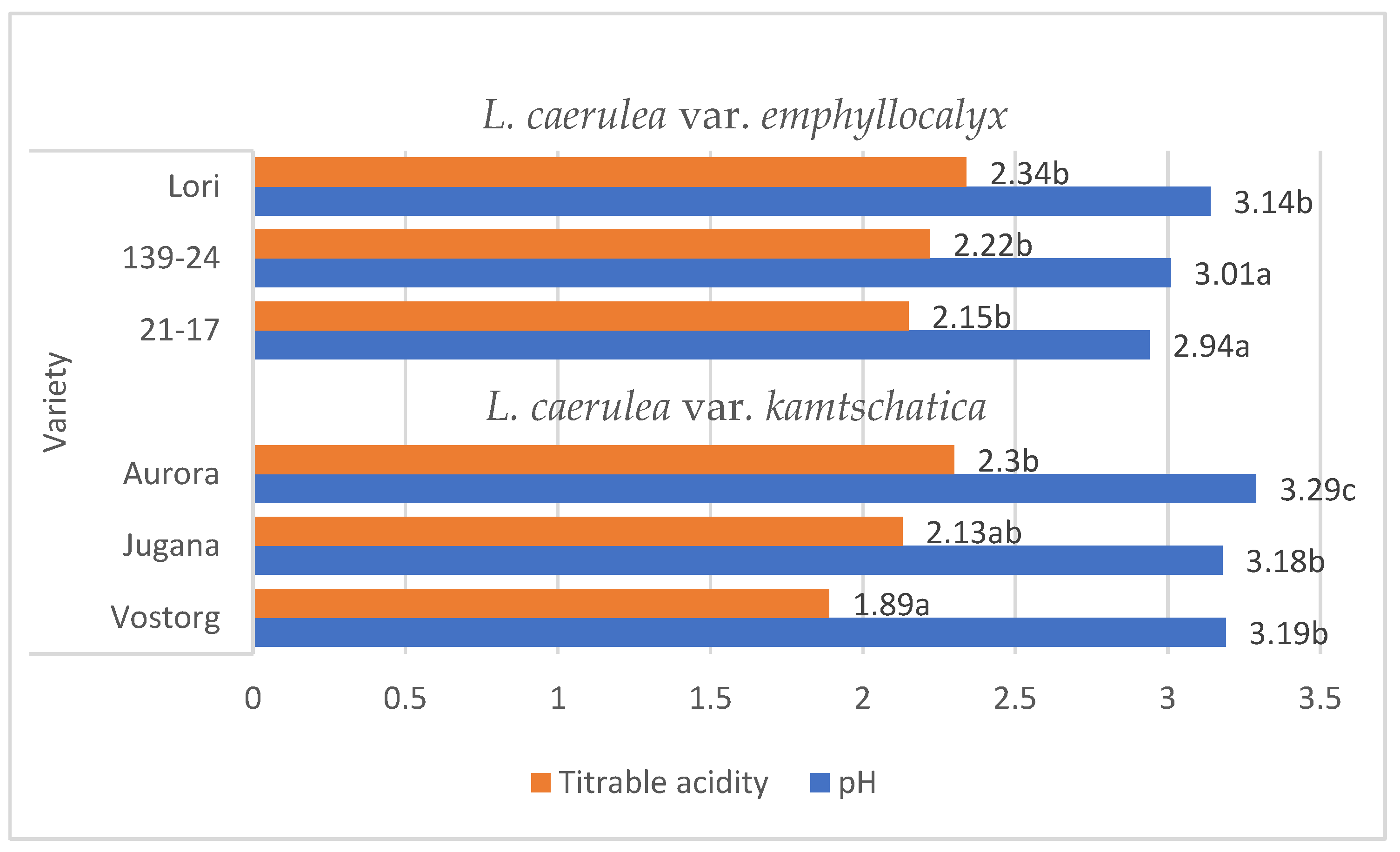
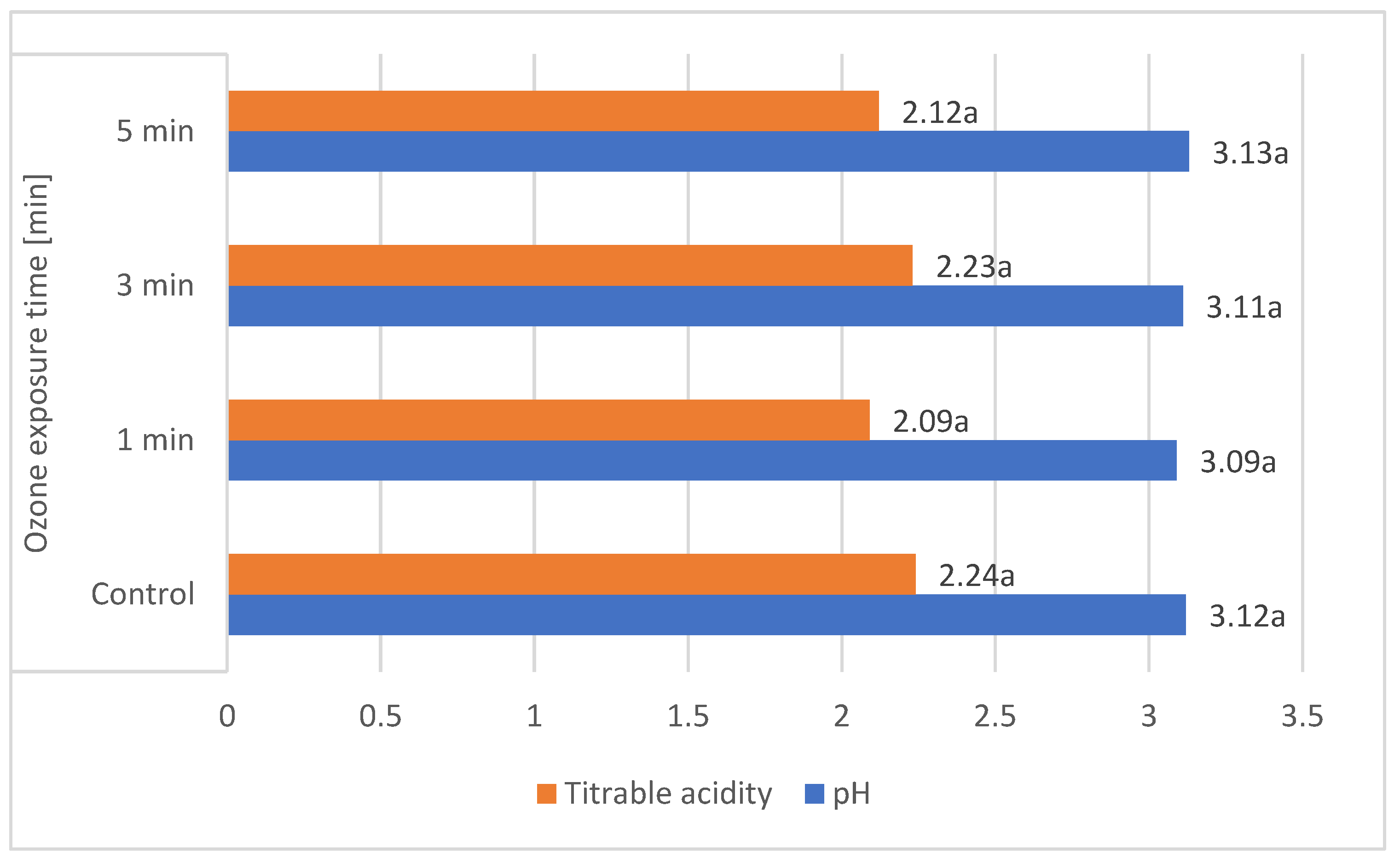
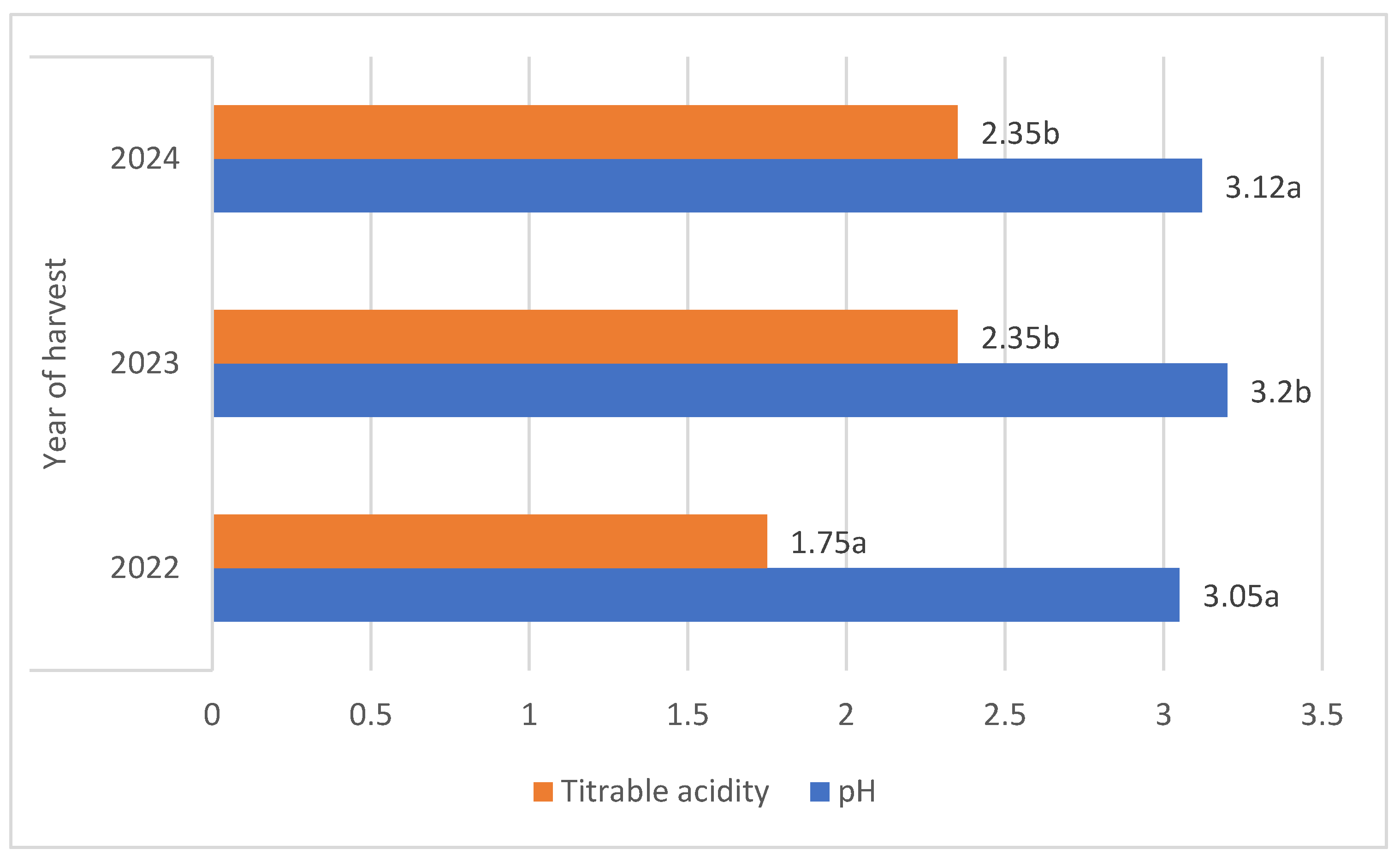
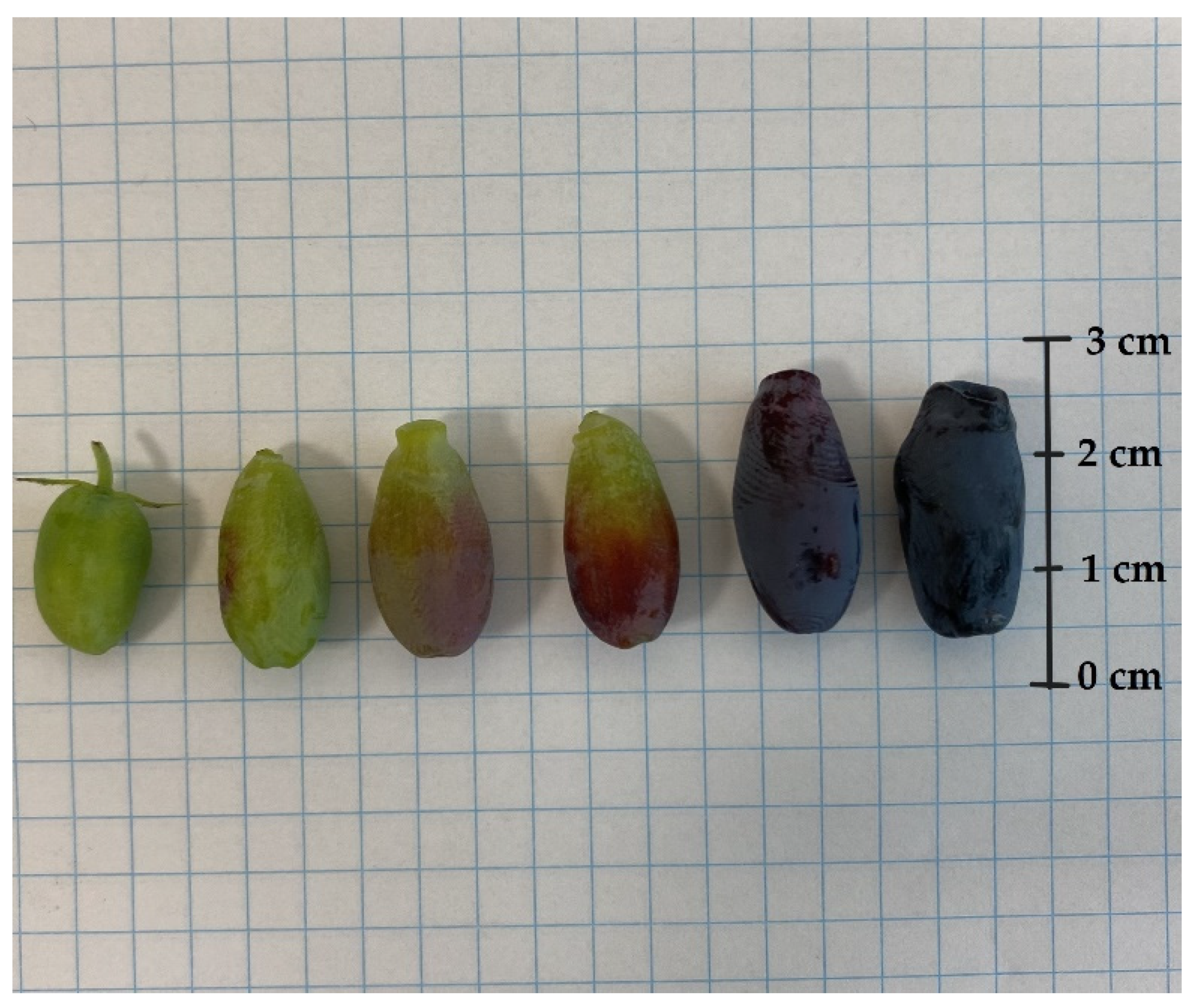
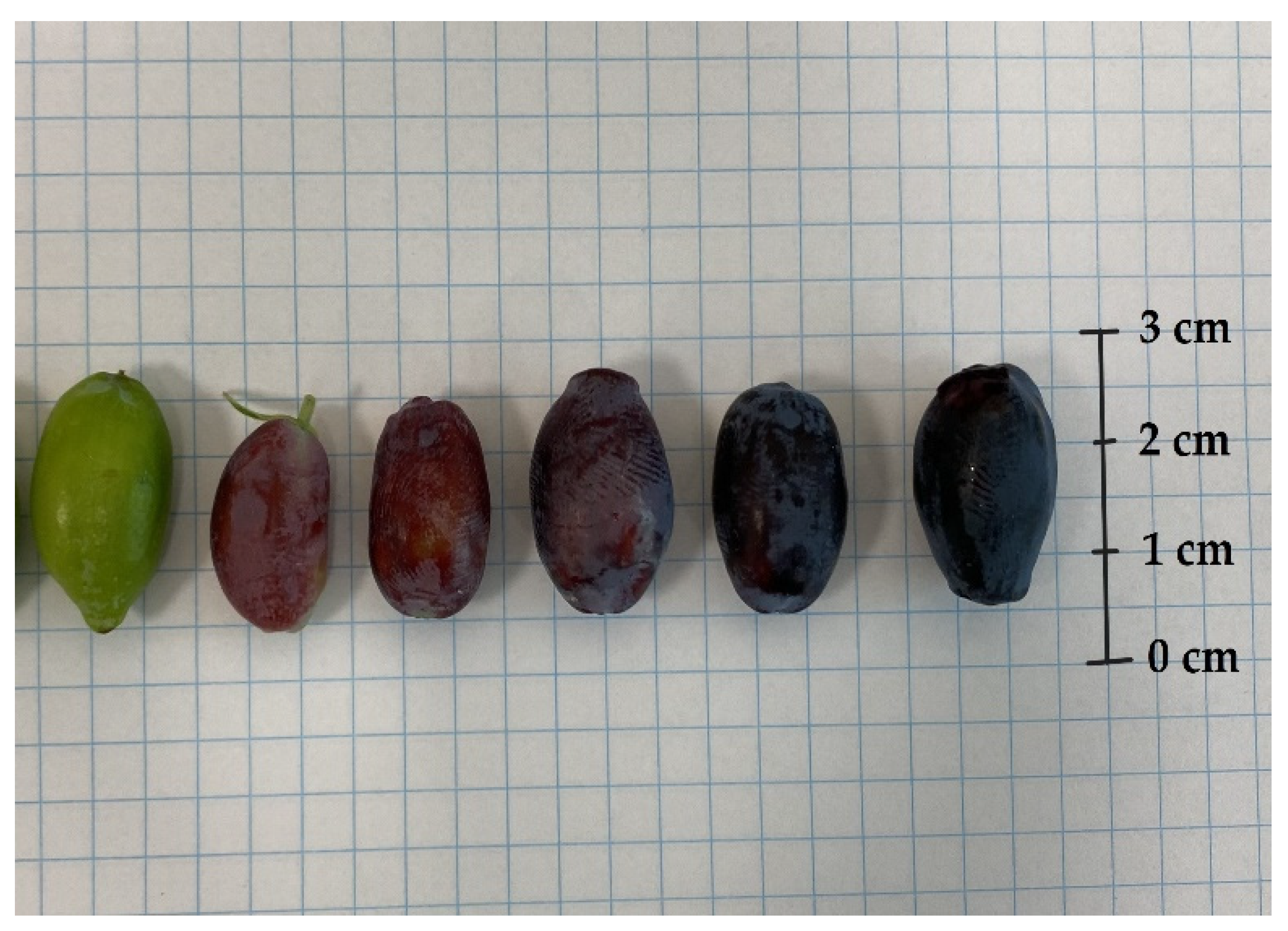
| Variety | Length [mm] | Width [mm] | Weight [g] | L* | a* | b* |
|---|---|---|---|---|---|---|
| L. caerulea var. kamtschatica | ||||||
| Vostorg | 22.54 b | 9.11 ab | 1.21 b | 27.74 a | 3.82 c | −2.87 c |
| Jugana | 23.49 b | 9.28 ab | 1.38 c | 26.79 a | 3.15 b | −2.43 b |
| Aurora | 18.46 a | 8.10 a | 0.86 a | 27.92 a | 2.92 b | −2.45 b |
| L. caerulea var. emphyllocalyx | ||||||
| Lori | 19.30 a | 8.95 a | 1.49 c | 27.94 a | 2.45 a | −2.06 a |
| 21-17 | 22.08 b | 11.09 c | 1.85 d | 29.21 b | 3.69 c | −2.49 b |
| 139-24 | 18.90 a | 12.07 c | 2.01 e | 27.76 a | 2.88 b | −2.30 a |
| SL | *** | *** | *** | * | *** | *** |
| Year of Harvest | 2022 | 2023 | 2024 | |||||||||
|---|---|---|---|---|---|---|---|---|---|---|---|---|
| Month of Year | III | IV | V | VI | III | IV | V | VI | III | IV | V | VI |
| Average temperature [°C] | 3 | 7 | 15 | 20 | 5.5 | 8.2 | 13.2 | 17.4 | 7 | 11 | 16 | 22 |
| The lowest temperature in the month [°C] | −2.5 | 2.4 | 7.7 | 13 | 0.9 | 3.4 | 7.1 | 12 | −3 | 1 | 5.7 | 10 |
| The highest temperature in the month [°C] | 8.9 | 12 | 21 | 27 | 7.7 | 13.3 | 18.9 | 23.1 | 9.5 | 17.2 | 20.5 | 23.1 |
| Rainfall [mm] | 28.1 | 51.1 | 38.8 | 27.3 | 79.8 | 45.9 | 52.1 | 45.4 | 23.1 | 35.6 | 59.4 | 67.3 |
| Variety | 2022 | 2023 | 2024 |
|---|---|---|---|
| Vostorg | 15 May | 17 May | 5 May |
| Jugana | 15 May | 17 May | 5 May |
| Aurora | 25 May | 29 May | 17 May |
| 21-17 | 12 June | 12 June | 5 June |
| 139-24 | 6 June | 8 June | 26 May |
| Lori | 6 June | 8 June | 30 May |
Disclaimer/Publisher’s Note: The statements, opinions and data contained in all publications are solely those of the individual author(s) and contributor(s) and not of MDPI and/or the editor(s). MDPI and/or the editor(s) disclaim responsibility for any injury to people or property resulting from any ideas, methods, instructions or products referred to in the content. |
© 2024 by the authors. Licensee MDPI, Basel, Switzerland. This article is an open access article distributed under the terms and conditions of the Creative Commons Attribution (CC BY) license (https://creativecommons.org/licenses/by/4.0/).
Share and Cite
Basara, O.; Gorzelany, J. Assessment of Selected Chemical and Morphological Properties of Lonicera var. kamtschatica and Lonicera var. emphyllocalyx Treated with Gaseous Ozone. Molecules 2024, 29, 3616. https://doi.org/10.3390/molecules29153616
Basara O, Gorzelany J. Assessment of Selected Chemical and Morphological Properties of Lonicera var. kamtschatica and Lonicera var. emphyllocalyx Treated with Gaseous Ozone. Molecules. 2024; 29(15):3616. https://doi.org/10.3390/molecules29153616
Chicago/Turabian StyleBasara, Oskar, and Józef Gorzelany. 2024. "Assessment of Selected Chemical and Morphological Properties of Lonicera var. kamtschatica and Lonicera var. emphyllocalyx Treated with Gaseous Ozone" Molecules 29, no. 15: 3616. https://doi.org/10.3390/molecules29153616
APA StyleBasara, O., & Gorzelany, J. (2024). Assessment of Selected Chemical and Morphological Properties of Lonicera var. kamtschatica and Lonicera var. emphyllocalyx Treated with Gaseous Ozone. Molecules, 29(15), 3616. https://doi.org/10.3390/molecules29153616







